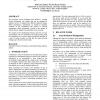Free Online Productivity Tools
i2Speak
i2Symbol
i2OCR
iTex2Img
iWeb2Print
iWeb2Shot
i2Type
iPdf2Split
iPdf2Merge
i2Bopomofo
i2Arabic
i2Style
i2Image
i2PDF
iLatex2Rtf
Sci2ools
VRST
2003
ACM
2003
ACM
Partitioning crowded virtual environments
We investigate several techniques that partition a crowded virtual environment into regions that can be managed by separate servers or mapped onto different multicast groups. When constructing a partitioning, we attempt to minimize overhead of the partitioning with respect to network management, whilst maintaining a bound on the number of entities that are mapped to any particular server or group. We compare several partitioning schemes: quad tree, k-d tree unconstrained, k-d tree constrained, and region growing. With our simulations of a crowded virtual environment modelled on a part of central London, we find that the region growing technique give the best overall results. Keywords Distributed virtual environments, spatial partitioning, multicast groups.
| Added | 05 Jul 2010 |
| Updated | 05 Jul 2010 |
| Type | Conference |
| Year | 2003 |
| Where | VRST |
| Authors | Anthony Steed, Roula Abou-Haidar |
Comments (0)

